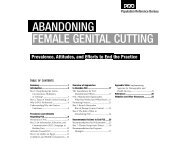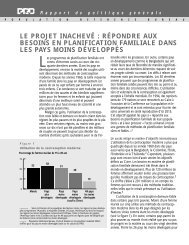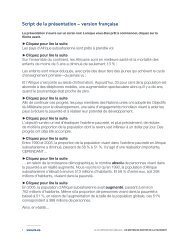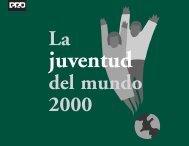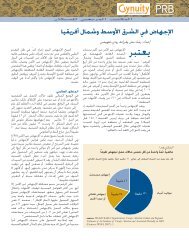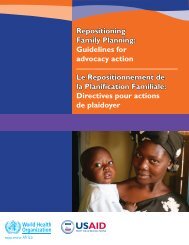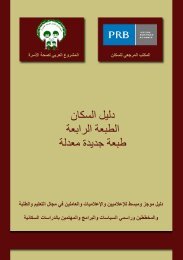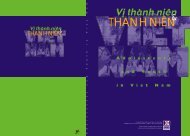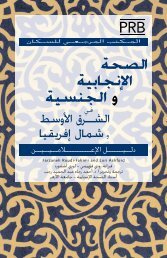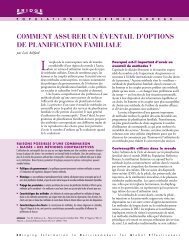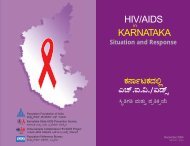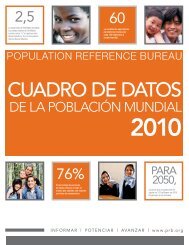MEASURE Communication Final Report - Population Reference ...
MEASURE Communication Final Report - Population Reference ...
MEASURE Communication Final Report - Population Reference ...
You also want an ePaper? Increase the reach of your titles
YUMPU automatically turns print PDFs into web optimized ePapers that Google loves.
14 <strong>MEASURE</strong> <strong>Communication</strong> <strong>Final</strong> <strong>Report</strong><br />
Following the release of new materials, <strong>MEASURE</strong><br />
<strong>Communication</strong> broadcast their availability via e-mail to<br />
numerous U.S. and international listservs and posted them<br />
on the project’s and PRB’s websites. The materials were also<br />
regularly displayed and disseminated at professional conferences<br />
(PAA, APHA, and GHC) and international technical<br />
and policy forums, such as numerous Cairo+5 meetings<br />
in 1999, Beijing+5 meetings in 2000, and the World<br />
Summit on Sustainable Development in 2002.<br />
Evidence of impact<br />
Orders for publications after initial mailings were a key<br />
indicator that <strong>MEASURE</strong> <strong>Communication</strong> publications<br />
contributed to policy learning by maintaining a steady flow<br />
of information. Over the course of the project, PRB<br />
received nearly 43,000 requests for a total of 344,101 copies<br />
of publications. Forty-one percent of these copies went to<br />
recipients in Africa, 20 percent to Latin America and the<br />
Caribbean, and 15 percent to South and Southeast Asia<br />
(see Table 3). The large demand for print materials in<br />
Africa probably resulted from the relevance of the materials<br />
to that continent’s reproductive health problems and the<br />
dearth of materials available locally (frequently mentioned<br />
in questionnaires and key informant interviews). Beginning<br />
in 2001, the bounceback questionnaires asked recipients to<br />
estimate how many people would SEE the reports and how<br />
many would USE them. In the 5,035 questionnaires that<br />
contained responses to these questions, recipients stated<br />
that a total of 630,716 people would see the reports and<br />
163,733 would use them. This represents an average of 125<br />
people seeing each copy, and 33 people using it. While<br />
these are estimates, it is clear that readership far exceeded<br />
the number of initial recipients.<br />
More requests originated in the United States (11 percent<br />
of additional copies distributed) than any other<br />
country because USAID cooperating agencies often<br />
requested copies for redistribution to their projects’ audiences<br />
in developing countries. Apart from these requests,<br />
TABLE 3<br />
COPIES OF INTERNATIONAL<br />
PUBLICATIONS REQUESTED, BY REGION<br />
Region<br />
% copies requested<br />
Sub-Saharan Africa 41<br />
Latin America & Caribbean 21<br />
South & Southeast Asia 15<br />
North America 11<br />
Oceania 7<br />
Middle East & North Africa 3<br />
Western Europe 1<br />
Eastern Europe & Eurasia 1<br />
25 percent of requests came from four developing countries<br />
(see Table 4), and 34 percent of requests came from<br />
the top six countries.<br />
In all, nearly 43,000 requests came from about 150<br />
countries, and roughly 40 percent of all organizational<br />
entries on the mailing list requested a publication. Some<br />
organizations repeatedly requested additional copies for<br />
distribution to their staff, field offices, and affiliates—and<br />
for redistribution in conferences and training workshops.<br />
While it is not possible to display the diversity of organizations<br />
here, Table 5 (page 15) lists those organizations<br />
that requested more than 1,000 copies of publications<br />
(multiple orders for multiple publications). These organizations<br />
represent diverse fields and countries, but most<br />
can be characterized as having both policy and educational<br />
missions in their countries and communities.<br />
The bounceback questionnaires included with all publications<br />
gathered evidence of policy learning through<br />
several multiple choice and open-ended questions.<br />
Readers could respond to multiple choice questions rating<br />
the usefulness and selecting from a range of possible uses.<br />
Open-ended questions asked readers to describe how the<br />
materials were used and whether the materials changed<br />
their views. The thousands of responses provided<br />
glimpses of incremental learning in many facets of<br />
national life as well as decisionmaking at a grassroots<br />
level. The following are illustrative examples from three<br />
publications that focused on reproductive health.<br />
Regarding “New <strong>Population</strong> Policies: Advancing<br />
Women’s Health and Rights”:<br />
It will be very helpful for policy development of women’s<br />
RH rights and designing programs.<br />
—Assistant Director, Women’s Program,<br />
Family Planning Association of Bangladesh,<br />
Dhaka, Bangladesh<br />
TABLE 4<br />
TOP 10 DEVELOPING COUNTRIES<br />
REQUESTING INTERNATIONAL<br />
PUBLICATIONS<br />
Country<br />
% copies requested<br />
India 8<br />
Nigeria 7<br />
Ghana 6<br />
Kenya 5<br />
Philippines 5<br />
Zimbabwe 3<br />
Bolivia 3<br />
Uganda 3<br />
Pakistan 2<br />
Peru 2




